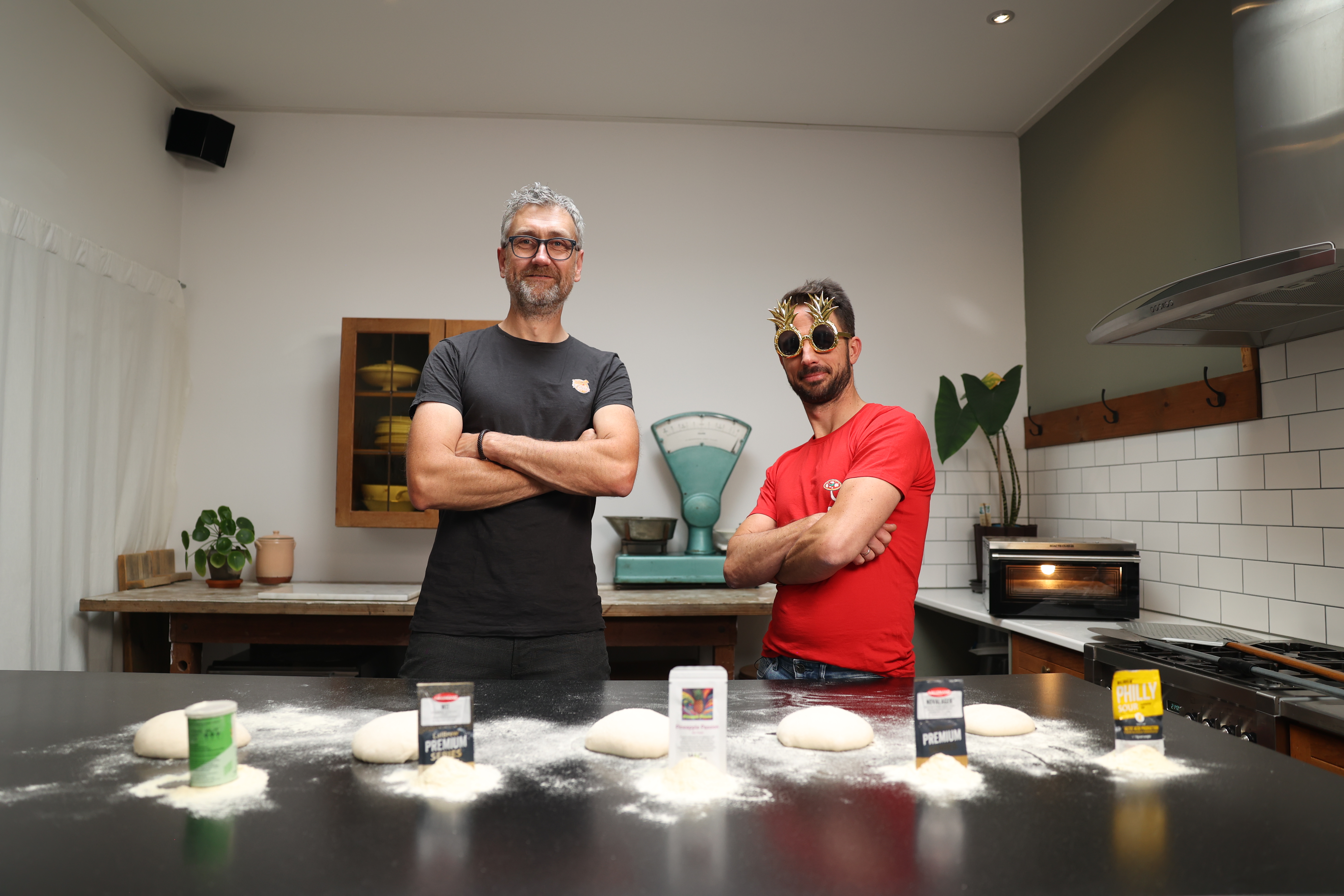







[VIDEO] Brewing dough with brewer's yeast

 2543 x views
2543 x views
Brewers use different types of yeast to give flavor to their brews. That’s where the term brewer’s yeast comes from. But Italian pizza makers also regularly use brewer’s yeast.
This led us to the following questions:
- Is brewer’s yeast the same as the yeast used by pizza makers to prepare dough?
- Can you actually make pizza dough with brewer’s yeast?
- How do different (brewing) yeasts influence the flavor of your pizza dough?
To explore this, we selected 4 different brewing yeasts from the wide range available at a brewing supply store. More information about these yeasts can be found further down this page.
“ Instant yeast, also a dry yeast, does not need to be activated first”
Our 4 brewing yeasts used

Pineapple Passion
Yeast type: Saccharomyces cerevisiae
Active dry yeast (ADY)
€4.99 for 11 g

Philly Sour
Yeast type: Lachancea spp
Active dry yeast (ADY)
€3.99 for 11 g

Novalager
Yeast type: Saccharomyces pastorianus
Active dry yeast (ADY)
€4.59 for 11 g

Wit
Yeast type: Saccharomyces cerevisiae
Active dry yeast (ADY)
€3.95 for 11 g
The ‘regular’ baker’s yeast we used for comparison
Yeast type: Saccharomyces cerevisiae
Active dry yeast (ADY)
€3.78 per 100 g (= equivalent to €0.38 per 10 g)
Active Dry Yeast or Instant Yeast?
If you search online for what active dry yeast (ADY) actually is, you’ll find countless pages saying that ADY is a dried yeast that needs to be activated (hydrated) before use. Instant yeast, which is also a dry yeast, does not need to be activated first.
We almost always use ADY to make our pizza dough. We never pre-activate the yeast but simply add it directly to the flour. We’ve never experienced any negative effects with this method. On the packaging of Caputo yeast (also an ADY), it even states that dissolving it in water first is not necessary.
Top Fermentation or Bottom Fermentation?
Brewers make a distinction between top fermentation and bottom fermentation.
-
In top fermentation (Saccharomyces cerevisiae), the yeast floats to the top of the wort. This fermentation takes place between 15–25 °C. These temperatures are challenging for brewers, as the risk of unwanted bacteria increases. As a result, the outcome can vary.
-
In bottom fermentation (Saccharomyces pastorianus), the yeast sinks to the bottom of the fermentation vessel. This process happens at lower temperatures, usually between 4–12 °C. Bottom fermentation takes longer but is less susceptible to bacteria, making the result more predictable. Pilsner is the best-known bottom-fermented beer.
Although pizza makers don’t use the terms top and bottom fermentation, there is an interesting parallel between brewing beer and making pizza dough. As a pizzaiolo, you can choose to let your dough ferment at room temperature or in the fridge. From a temperature perspective, that’s somewhat comparable to top versus bottom fermentation.
For this video, however, we didn’t make a distinction in temperature. All our doughs—made with the different yeasts—were given the same treatment. We left them to bulk ferment and proof at room temperature; no refrigeration was used.
It’s possible that flavor differences would have emerged if we had developed the Saccharomyces cerevisiae doughs at room temperature and the Saccharomyces pastorianus dough in the fridge. But that wasn’t part of this test.
How Did the Dough Rise with Brewing Yeast?
From left to right in the photo: 1. Baker’s yeast 2. Belgian Wit 3. Pineapple Passion 4. Novalager 5. Philly Sour
The photo of the dough balls was taken just before we started baking pizzas in the video. The most visible difference was that the Philly Sour dough balls rose noticeably slower than the rest. They ended up flatter and with less volume.
It may not be entirely clear from the photo, but the dough balls on the far left, made with baker’s yeast (Saccharomyces cerevisiae), had the most volume overall. Wit and Pineapple Passion (both also Saccharomyces cerevisiae) weren’t far behind.
The Novalager (Saccharomyces pastorianus) lagged just slightly, but still produced nicely airy dough balls.
Conclusion
You can definitely make pizza dough with brewing yeast. However, the unique flavor notes that yeast contributes when brewing beer are hardly noticeable in pizza dough. The only clear exception was Philly Sour, which gave the dough a distinct fresh-sour flavor.
But is it worth the price of the yeast? In our opinion, it’s cheaper and more effective to use a starter if you’re aiming for that kind of flavor profile.
Can You Brew Beer with Baker’s Yeast?
We haven’t tested this ourselves—we’re pizza makers, not brewers—but we did find reports online of brewers experimenting with baker’s yeast. The conclusion: baker’s yeast does work for fermentation, but brewing yeasts give better results and more distinct styles.
That’s why beer yeasts are clearly labeled for the style of beer they’re suited for (lager, IPA, tripel, wit, etc.).
Types of Brewing Yeast for Every Beer Style
At Brouwland you’ll find an extensive selection of brewing yeasts, each suited for different beer styles:
- Bottom Fermentation (Saccharomyces pastorianus): Ideal for brewing lagers and pilsners. Ferments at lower temperatures, producing a clean and crisp taste.
- Top Fermentation (Saccharomyces cerevisiae): Perfect for ales, IPAs, tripels, and other top-fermented beers. Ferments at higher temperatures, creating rich and complex flavor profiles.
- Spontaneous Fermentation (Brettanomyces): Used for specialty beers like lambic and gueuze, providing unique, wild flavors.




 0
0